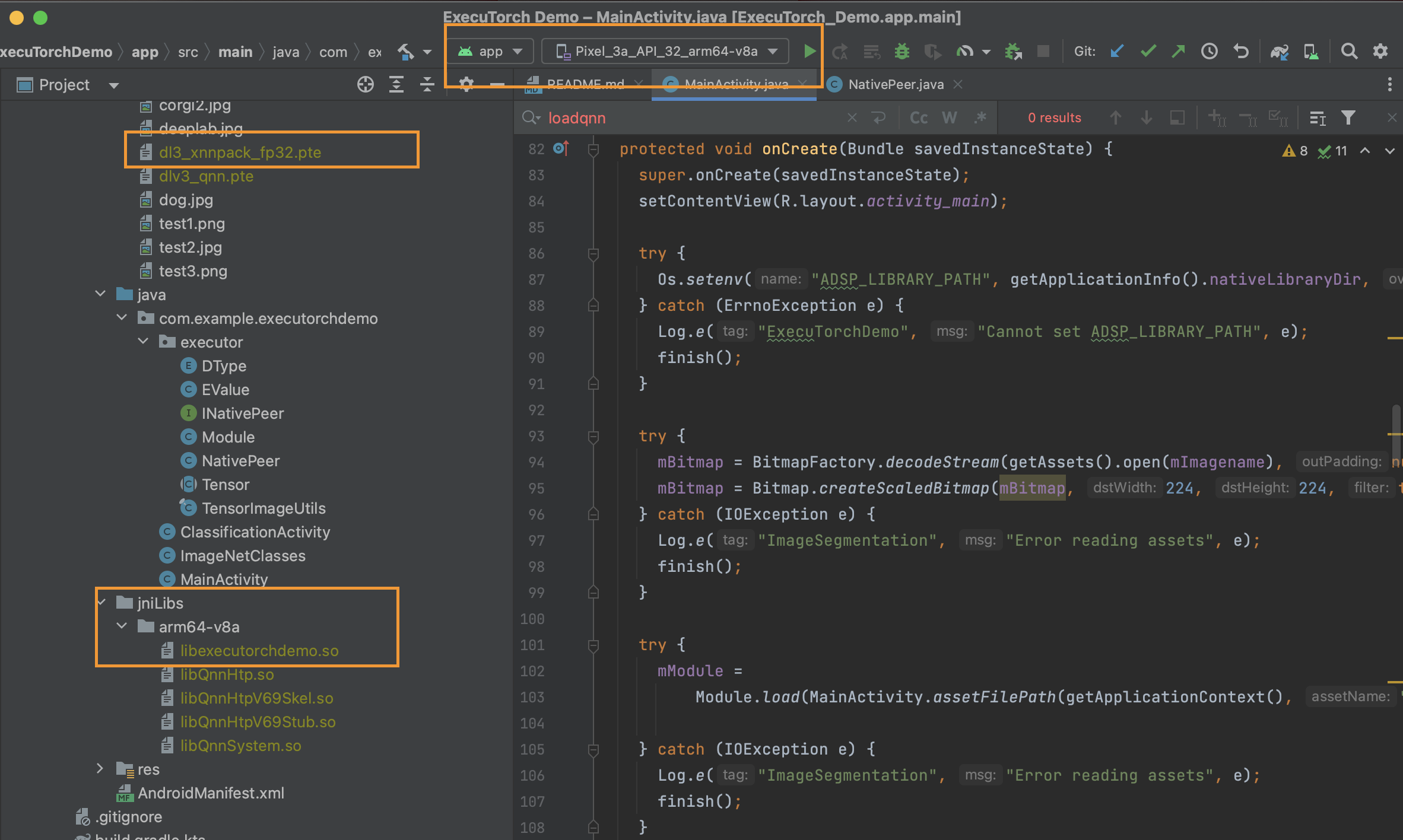Building an ExecuTorch Android Demo App¶
This is forked from PyTorch android demo app.
This guide explains how to setup ExecuTorch for Android using a demo app. The app employs a DeepLab v3 model for image segmentation tasks. Models are exported to ExecuTorch using XNNPACK FP32 backend.
How to set up a build target for Android arm64-v8a
How to build the required ExecuTorch runtime with JNI wrapper for Android
How to build the app with required JNI library and model file
Refer to Setting up ExecuTorch to set up the repo and dev environment.
Download and install Android Studio and SDK.
Optional: To use Qualcomm HTP Backend, download and install Qualcomm Neural Processing SDK
Supported Host OS: CentOS, macOS Ventura (M1/x86_64). To use Qualcomm QNN SDK, Linux is required.
ExecuTorch Configuration¶
Configure the libraries for Android:
Configure a library with XNNPACK backend only
Note
This demo app and tutorial has only been validated with arm64-v8a ABI.
export ANDROID_NDK=<path-to-android-ndk>
rm -rf cmake-out && mkdir cmake-out && cd cmake-out
cmake .. \
-DCMAKE_TOOLCHAIN_FILE=$ANDROID_NDK/build/cmake/android.toolchain.cmake \
-DANDROID_ABI=arm64-v8a \
-DBUCK2=/tmp/buck2 \
-DEXECUTORCH_BUILD_ANDROID_DEMO_APP_JNI=ON \
-DEXECUTORCH_BUILD_XNNPACK=ON \
-DEXECUTORCH_BUILD_FLATC=OFF \
-DEXECUTORCH_BUILD_EXTENSION_DATA_LOADER=ON
When we set EXECUTORCH_BUILD_XNNPACK=ON, we will build the target xnn_executor_runner_lib which in turn is linked into libexecutorchdemo via CMake.
libexecutorchdemo.so wraps up the required XNNPACK Backend runtime library from xnn_executor_runner_lib, and adds an additional JNI layer using fbjni. This is later exposed to Java app.
Optional: Configure a library with XNNPACK and Qualcomm HTP backend
Note
Qualcomm SDK is required for this step.
export ANDROID_NDK=<path-to-android-ndk>
export QNN_SDK=<path-to-qnn-sdk>
rm -rf cmake-out && mkdir cmake-out && cd cmake-out
cmake .. \
-DCMAKE_TOOLCHAIN_FILE=$ANDROID_NDK/build/cmake/android.toolchain.cmake \
-DANDROID_ABI=arm64-v8a \
-DBUCK2=/tmp/buck2 \
-DEXECUTORCH_BUILD_ANDROID_DEMO_APP_JNI=ON \
-DEXECUTORCH_BUILD_XNNPACK=ON \
-DEXECUTORCH_BUILD_FLATC=OFF \
-DEXECUTORCH_BUILD_QNN=ON \
-DQNN_SDK_ROOT=$QNN_SDK \
-DEXECUTORCH_BUILD_EXTENSION_DATA_LOADER=ON
Similar to the previous XNNPACK library, with this setup, we compile libexecutorchdemo.so but it adds an additional static library qnn_executorch_backend which wraps up Qualcomm HTP runtime library and registers the Qualcomm HTP backend. This is later exposed to Java app.
qnn_executorch_backend is built when we turn on CMake option EXECUTORCH_BUILD_QNN. It will include the CMakeLists.txt from backends/qualcomm where we add_library(qnn_executorch_backend STATIC).
Building and Copying Libraries¶
Build the libraries:
cmake --build . -j16
Copy the libraries to the appropriate location to link against them:
Navigate to the build artifacts directory:
mkdir -p ../examples/demo-apps/android/ExecuTorchDemo/app/src/main/jniLibs/arm64-v8a
Copy the core libraries:
cp ./examples/demo-apps/android/jni/libexecutorchdemo.so \
../examples/demo-apps/android/ExecuTorchDemo/app/src/main/jniLibs/arm64-v8a
Later, this shared library will be loaded by NativePeer.java in Java code.
Qualcomm HTP Only: Copy Qualcomm HTP runtime library:
cp libQnnHtp.so libQnnHtpV69Skel.so libQnnHtpStub.so libQnnSystem.so \
../examples/demo-apps/android/ExecuTorchDemo/app/src/main/jniLibs/arm64-v8a
Return to the
executorchdirectory:
cd ..
Model Download and Bundling¶
Note
Please refer to XNNPACK backend and Qualcomm backend for the full export tutorial on backends.
Export a DeepLab v3 model backed with XNNPACK delegate and bundle it with the app:
export FLATC_EXECUTABLE=$(realpath third-party/flatbuffers/cmake-out/flatc)
python3 -m examples.xnnpack.aot_compiler --model_name="dl3" --delegate
mkdir -p examples/demo-apps/android/ExecuTorchDemo/app/src/main/assets/
cp dl3_xnnpack_fp32.pte examples/demo-apps/android/ExecuTorchDemo/app/src/main/assets/
Qualcomm HTP Only: Copy HTP delegation models to the app:
cp dlv3_qnn.pte examples/demo-apps/android/ExecuTorchDemo/app/src/main/assets/

